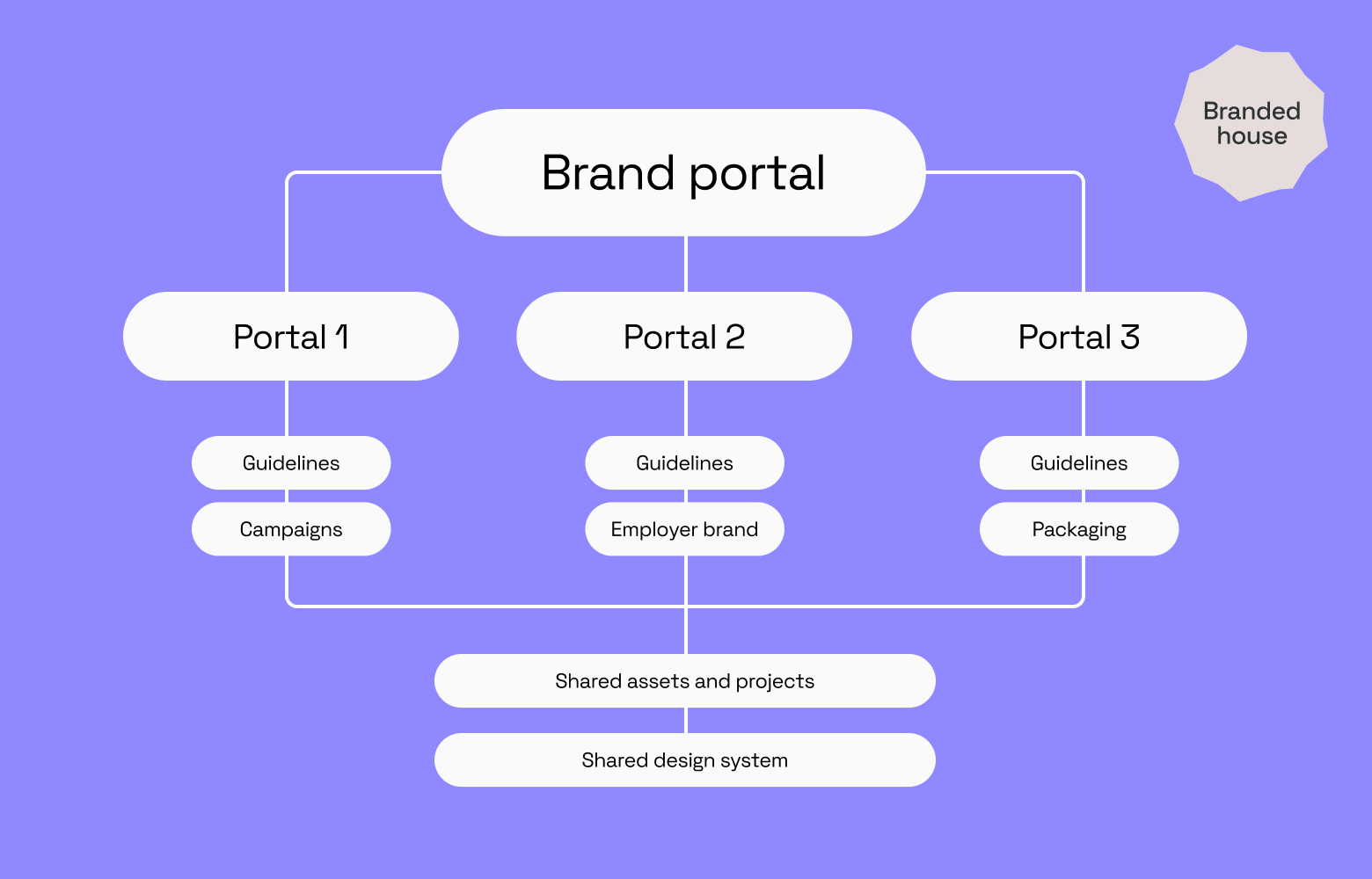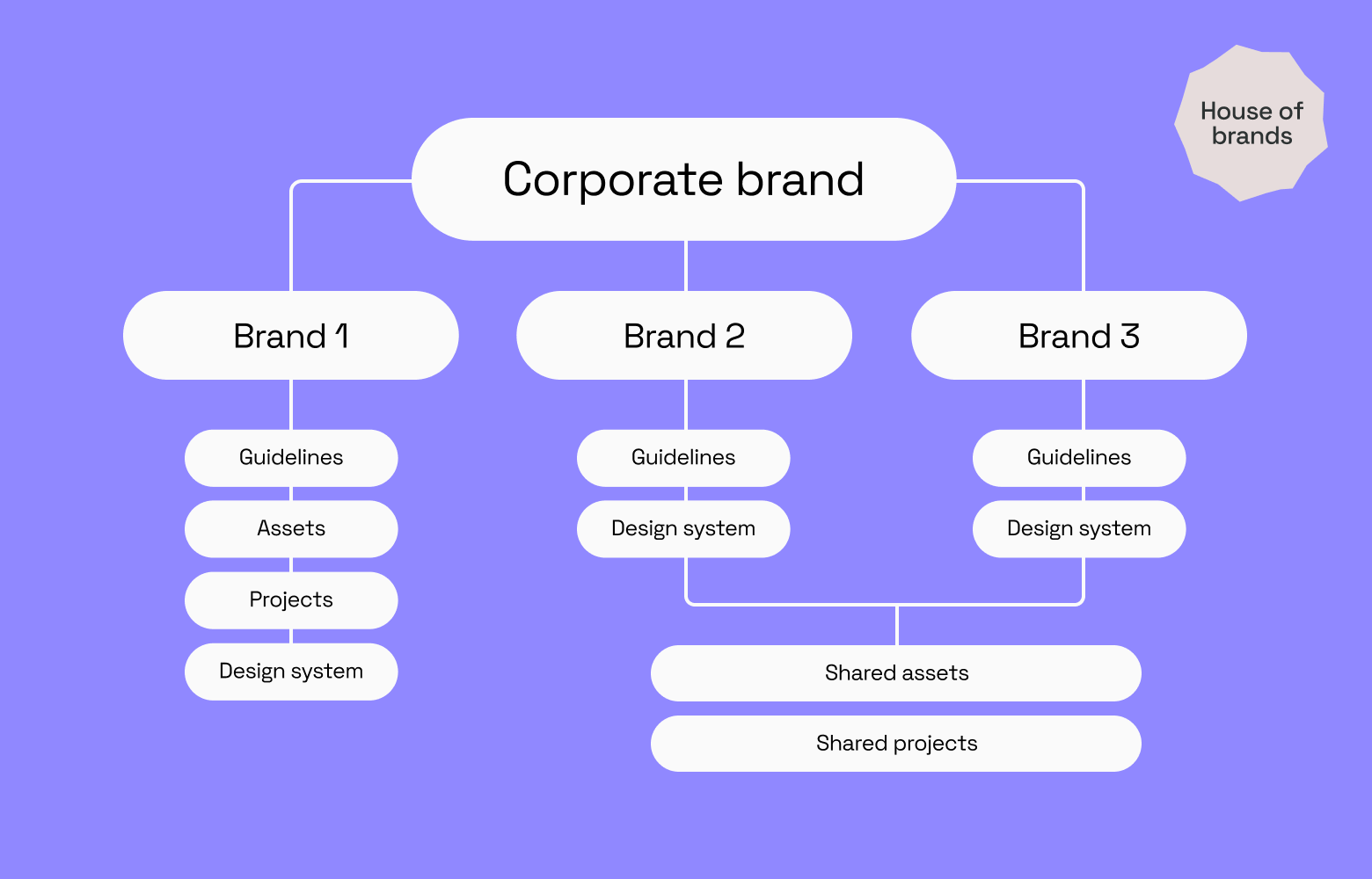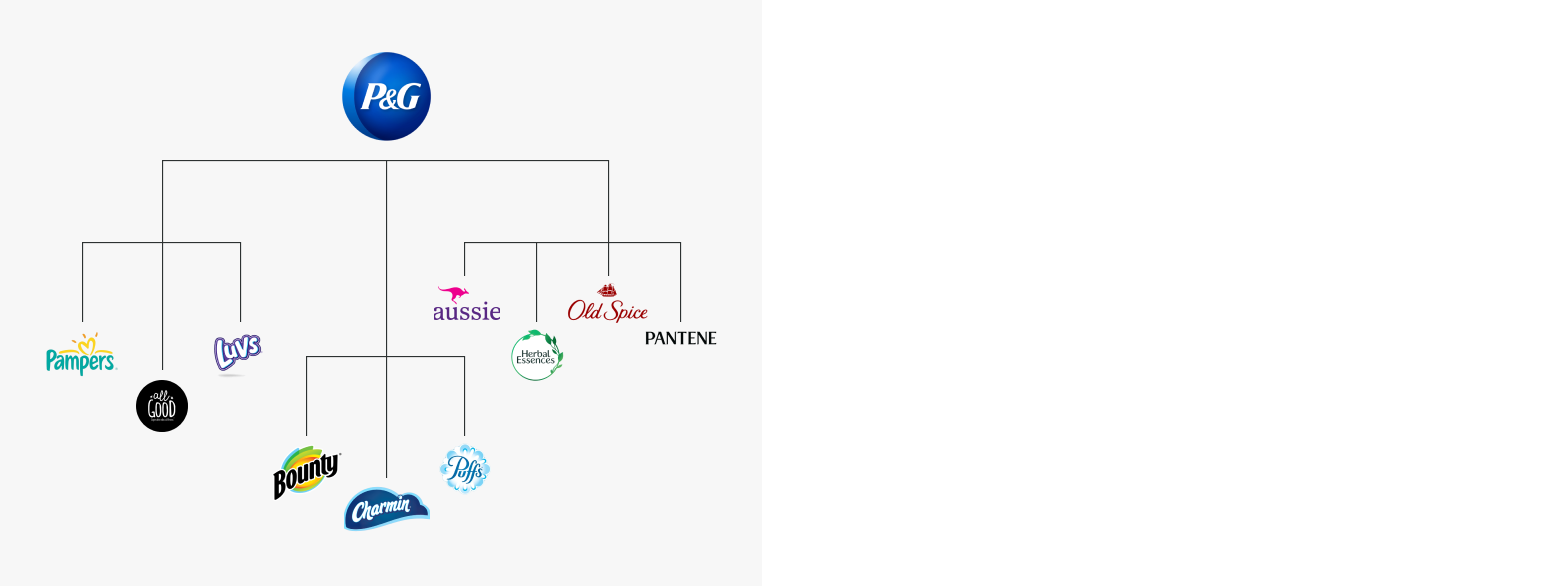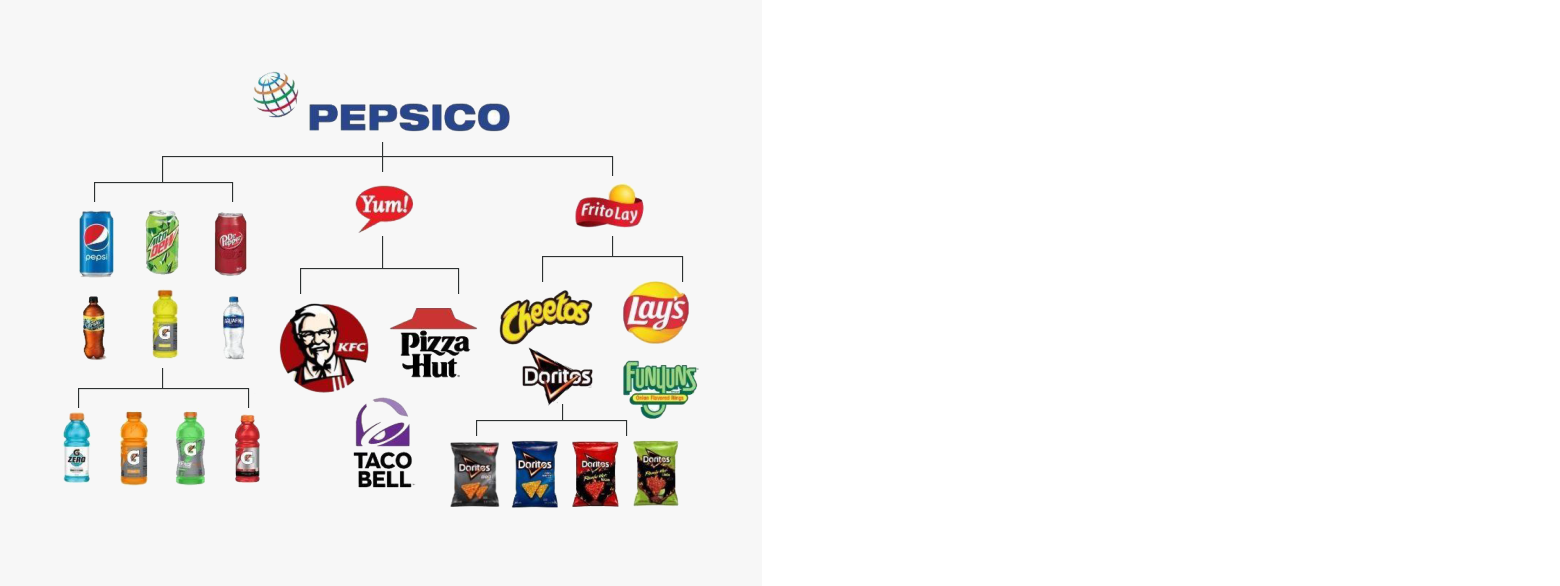
What is brand architecture? Everything you need to know.
Brand architecture is the framework a company relies on to visualize and manage connections between a parent company and its sub-brands.
What do Doritos, Crunchwrap Supremes, and Mountain Dew all have in common?
If you guessed that they’re all Taco Bell menu items, congratulations! You’re exactly right. But there’s a deeper connection between these products that explains why so many different brands can be found on one fast-food restaurant menu.
All of these brands are owned by Taco Bell’s parent company: PepsiCo. That’s also why you can get a Mountain Dew Baja Blast at Taco Bell (but not anywhere else).
Whether you realize it or not, all of these brands and products work together to help each other — and ultimately PepsiCo — succeed. Setting up a solid brand architecture is important for every brand — not just giant multi-brand corporations like PepsiCo.
What is brand architecture?
Brand architecture is the organized structure that defines how a company's brands, sub-brands, products, and services relate to and interact with each other. It acts as a strategic framework that helps organizations manage their brand portfolio, guide future growth, and communicate brand relationships clearly to customers.
Brand architecture determines how different brands within a company support and enhance each other while maintaining their distinct market positions.
How does brand architecture help companies?
When a company has more than one product line, service offering, or sub-brand, it’s easy to lose track of the qualities that make each one unique or focus so much on differentiation that the parent brand’s key values get lost.
Maintaining the relationship between the parent — or master — brand and its subsidiaries becomes easier through clear brand architecture:
-
Establish clear brand identities: Outlining how individual components relate to one another helps internal stakeholders understand how to segment messaging and differentiate brand identities without compromising the cohesive vision of the master brand.
-
Improve brand equity: When customers understand how individual brands and products connect to each other, it’s easy to expand product lines and grow into new markets because the positive reputation of one brand often translates to its sub-brands or sister brands.
-
Generate more revenue: Brand architecture helps identify cross-promotion and cross-selling opportunities, which allow related brands to support each other’s success — just take the successful relationship between Taco Bell and Mountain Dew’s Baja Blast as an example.
-
Identify growth opportunities: Creating a visual representation of a brand’s hierarchy allows you to highlight gaps in product and service offerings. And that, in turn, makes it easier to find new avenues for potential business growth and create a realistic plan to pursue them.
How to identify poor brand architecture: 3 key questions to ask
If you’re concerned about your brand’s performance, it may be due to poor brand architecture. Ask yourself these three questions to find out.
1. What does brand and product line performance look like?
There are many reasons why one of your offerings might be underperforming — including poor brand architecture. It’s incredibly difficult to build a successful brand or drive growth without a solid framework to guide marketing, product development, and sales. A strong brand architecture, however, makes it easier to establish a clear brand identity, communicate key values, and build customer loyalty.
Audit your underperforming brand to determine how well customers understand its identity and offerings. If perceptions are positive and consumers are knowledgeable about the brand and its products, architecture isn’t likely to be the culprit for poor performance. But a lack of consumer knowledge or confusion about your brand’s values is a sign that your architecture isn’t doing enough to clear up confusion.
In a perfect world, you’ll see balanced performance across all your brands — including no overperforming brands. But if one brand or product offering is vastly outperforming the others in your portfolio, it’s a sign that you aren’t maximizing the value of brand architecture. Over time, this outsized success will make it harder to invest in other sub-brands and product offerings, limiting their potential for success.
A visual map of your branded offerings makes it easy to identify cross-promotion and partnership opportunities that build on the success of top-performing brands and offerings.
2. What kind of change is the business experiencing?
With every evolution, a brand adapts its operations to reflect the new changes. And that means it’s vital to update your brand architecture any time your business experiences a major change in its strategy — especially when entering (or leaving) markets, expanding offerings, retiring products, or acquiring a new brand.
3. How successful is current brand positioning?
Do customers understand your brand the way you want them to? If they don’t share your vision of what each individual brand’s identity is or understand the relationship between brands and products, it’s a sign that your brand architecture isn’t clearly defined.
Creating a strong brand identity starts with your people — if employees and brand partners don’t understand your brand or its relationship with related brands, they won’t be able to explain it to consumers either.
As an internal tool, brand architecture can help prevent confusion by enabling everyone to understand everything a brand has to offer. It also serves as an organizational tool to house branded resources.
Examples of brand architecture models and frameworks
Companies organize their brands, products, and services in a variety of ways. While some rely heavily on the master or parent brand as a core element of all sub-brands, other organizations maintain distinct identities for each. This looks different for every business, but generally, companies with multiple brands use one of three basic architectures to organize their brand: the branded house, the house of brands, or a hybrid of the two.
Branded house model

A branded house contains multiple brand portals that build its presence around the strong identity of a central master brand. Typically, the portals each target a different audience or have different offerings. But they share core elements of the master brand’s identity, including its mission, values, and brand elements like the color palette. And they all work together to support the goals of the parent company.
Branded House benefits
The branded house model of architecture offers a few advantages:
- Straightforward layout and design: This architecture is often the simplest framework to draw up and explain to stakeholders because each brand portal holds a similar position within the corporate hierarchy.
- Built-in cohesion: Because each brand shares key elements — the brand name, color palettes, and design elements like logos — employees are more likely to create a cohesive identity across multiple touchpoints.
- Shared brand vision: The shared mission and values help keep everyone aligned, ensuring each portal works to support the other portals and, more importantly, the parent brand.
Branded House examples

Small businesses with regional audiences also benefit from a branded house architecture because it allows them to build on prior successes and lean into “support local” initiatives. Take regional restaurant Snarf’s as an example — the restaurant uses a branded house model to build brands for its two sandwich chains.

When to avoid the Branded house model
Maintaining close relationships between all sub-brands isn’t a good idea if all of the sub-brands have vastly different offerings or target audiences. If there isn’t a clear connection between all of the sub-brands, customers won’t understand the mission of the parent brand.
The branded house model also increases the impact of mistakes — if one brand makes a misstep that damages its reputation, it can have a ripple effect on the sister brands as well as the parent brand.
House of brands framework

A house of brands may look similar to the branded house architecture, but in practice, it operates much differently. Under this model, the parent brand isn’t clearly tied to its subsidiaries. Instead, each brand works independently — from how they operate to how they brand themselves. While they may occasionally enter into partnerships, brands under this model typically don’t have any impact on each other’s operations.
House of brand benefits
A house of brands architecture is a good option for a couple of reasons:
- Unlimited creative limits: Since brands under this model don’t need to share brand elements, each has the freedom to rebrand or make operational changes that will maximize its own success.
- Full ownership of the brand identity: Because brands operate independently, if one makes a misstep, it’s unlikely that it will have an impact on any of its sibling brands.
House of brand examples
Just because a company’s subsidiaries operate independently doesn’t mean that they don’t have similar operations. Just like General Motors, whose sub-brands all operate in the automotive industry, all of Yum! Brands’ subsidiaries have something in common: They’re all restaurants.

Procter and Gamble’s sub-brands are much more varied, but all of them serve personal hygiene and home care needs.

When to avoid the house of brands framework
Building an individual brand from the ground up is difficult and expensive. And the more brands you have to develop and eventually scale, the harder and more costly it will be. That means this framework isn’t a realistic option for small organizations with limited resources.
Managing multiple, distinctly different brands can also create confusion for internal stakeholders who have to understand and communicate each identity to the public.
Hybrid brand architecture

Hybrid brand architecture is a combination of the branded house and house of brands frameworks we just described above. Under this model, some brands act independently — without any connection to the parent brand – while others operate directly under the master brand or parent company.
Hybrid brand architecture benefits
A hybrid framework is a great option for multi-brand architecture:
- Flexible framework: Hybrid architecture accommodates multiple sub-brand types, making it easy to adapt the framework to the business as it evolves.
- Unique brand identities: This model allows for the most variance in the hierarchy, making it easy to diversify one sub-brand without worrying about the impact it will have on another.
Hybrid brand architecture examples
Hybrid architecture makes it easy to leverage the power of different brand identities. Just consider Google’s acquisition of YouTube — Google could have renamed the platform to something like “GoogTube” as a way to signify YouTube’s association with Google’s suite of products. But it didn’t. YouTube’s identity already had its own brand power. And Google didn’t want to lose that.

When to avoid the hybrid brand architecture
While combining other frameworks allows you to leverage twice as many benefits, it also comes with double the risk. Hybrid brand architectures are more complex and harder to maintain than either of the other architecture models because they often contain elements of both. For example, PepsiCo owns the Yum! house of brands and the Frito-Lay branded house.
Under a hybrid structure like PepsiCo’s, there are multiple identities and different types of brand relationships to consider, which means you’ll need a larger team to manage each individual identity. And finding co-branding and partnership opportunities will require much more collaboration and planning, which introduces more opportunities for error.
How to create a cohesive brand architecture
Since your brand doesn’t share the same values, operational plans, or sub-brands with any other business, your architecture will be unique. That’s why it’s a good idea to create your architecture early rather than waiting until you have a complex business to map out and multiple brands to conceptualize.
As your brand grows and diversifies its offerings, having a defined architecture handy will give you a competitive advantage — all you’ll need to do is update it as your brand expands. But if you wait, marketing and brand teams won’t have the direction they need to create messaging for new brands and product lines.
That said, brand architecture shouldn’t be a static framework — brand building is a continuous process that evolves. Your architecture should evolve with your brand as it grows to ensure it remains accurate and effective.
1. Conduct research to understand brand positioning
First and foremost, it’s vital to understand a company’s corporate portfolio, including what subsidiaries it owns and what they offer. Then conduct a brand audit for each brand and research the target audiences to understand current brand positioning, from the logo each brand uses to how consumers perceive them.
This information will help you chart the connection between different brands and products. Collecting assets for each brand — logos, images, and style guides — means you’ll be able to transform your brand architecture from a visual chart to a functional resource for your team.
2. Choose an established model as a foundation
Once you understand the different elements of the master brand, choosing an established model — branded house, house of brands, or a hybrid — will help you get started. Rather than creating brand architecture from scratch, you can customize the frameworks to match your brand:
- Add or remove brands and product lines, like when Google acquired YouTube.
- Offer descriptions of each brand’s identity — just take a look at how Procter & Gamble breaks down its subsidiaries by category.
- Incorporate unique resources — consider Gallaudet University’s brand book, which outlines the brand’s architecture and includes links to download assets like branded fonts.
3. Put the architecture into action
Brand architecture is useful as a visual tool that represents each brand’s relationship to each other. But architecture is much more valuable when brands use it as the framework for their brand guidelines. That way, everyone can access it to gain clarity about branding for different subsidiaries and access resources for each brand.
Just take Meta’s digital guidelines as an example. Each of Meta’s products has its own page in the guidelines. And each page offers clear communication about its respective brand. For example, the page for Facebook describes the purpose of the social media platform and offers links to various resources, including Facebook’s unique brand guidelines.
Create a holistic, multi-brand architecture with Frontify
A digital tool like Frontify’s brand portal makes it easy to outline and share brand architecture and guidelines with everyone on your team in a way that they can easily understand. It allows everyone to see the architecture diagram and access resources that help them represent each brand identity authentically and consistently.
Learn more about how Frontify can help you create a multi-brand architecture that’s as unique as your business.